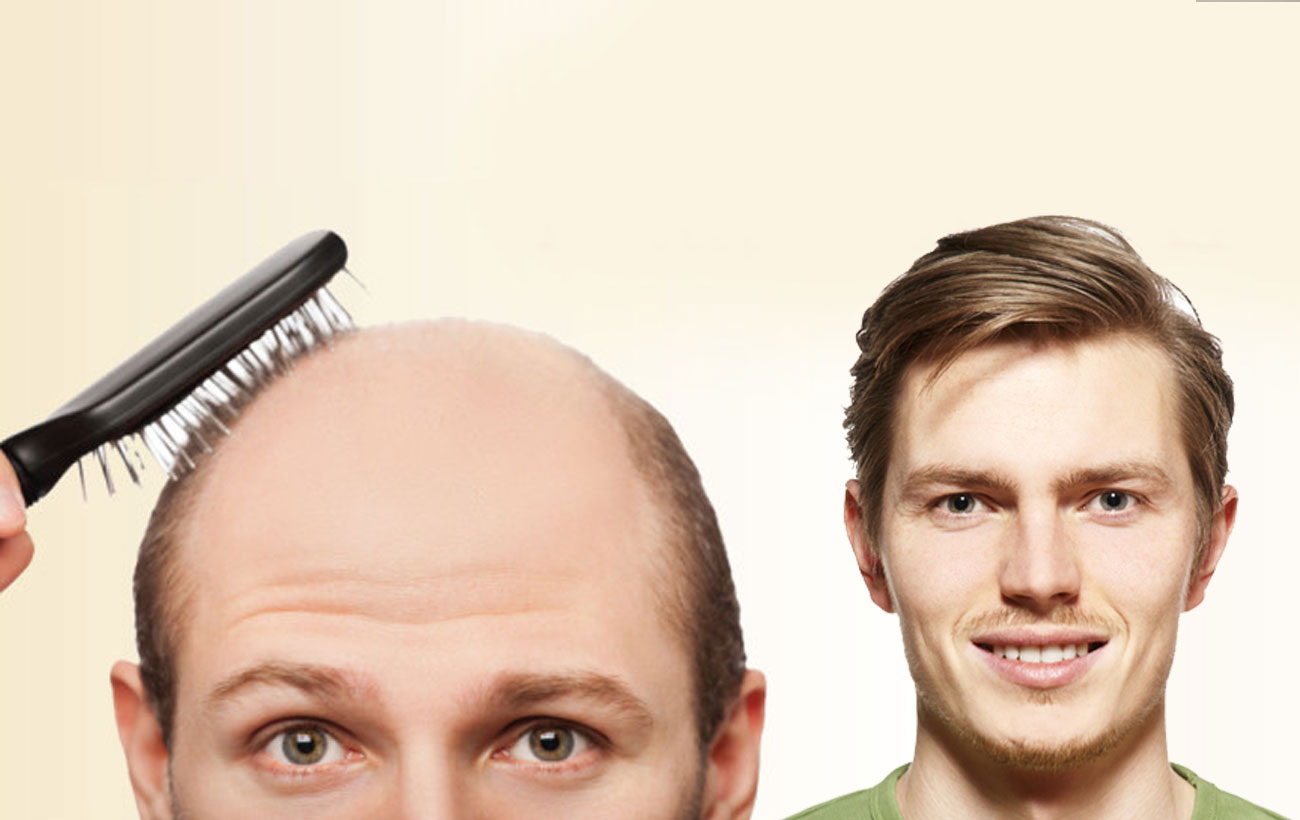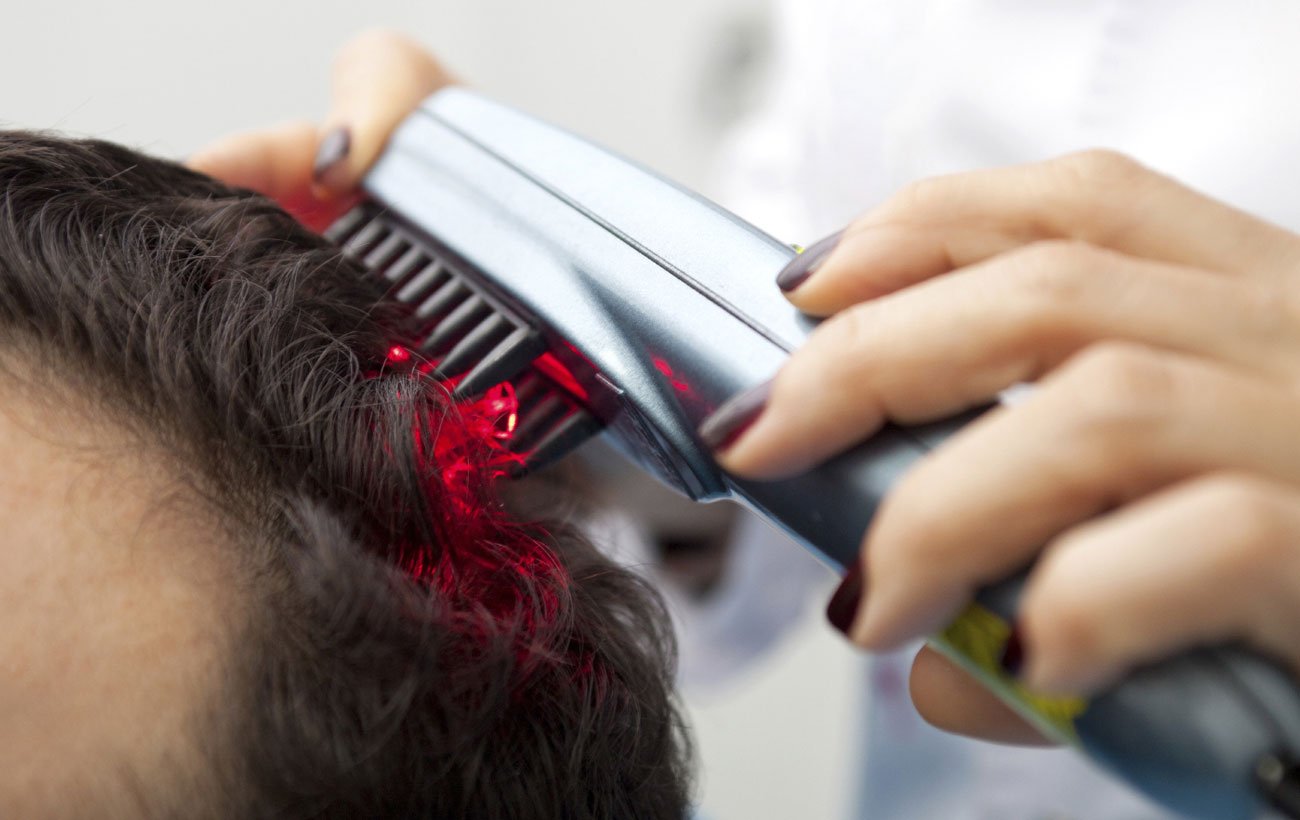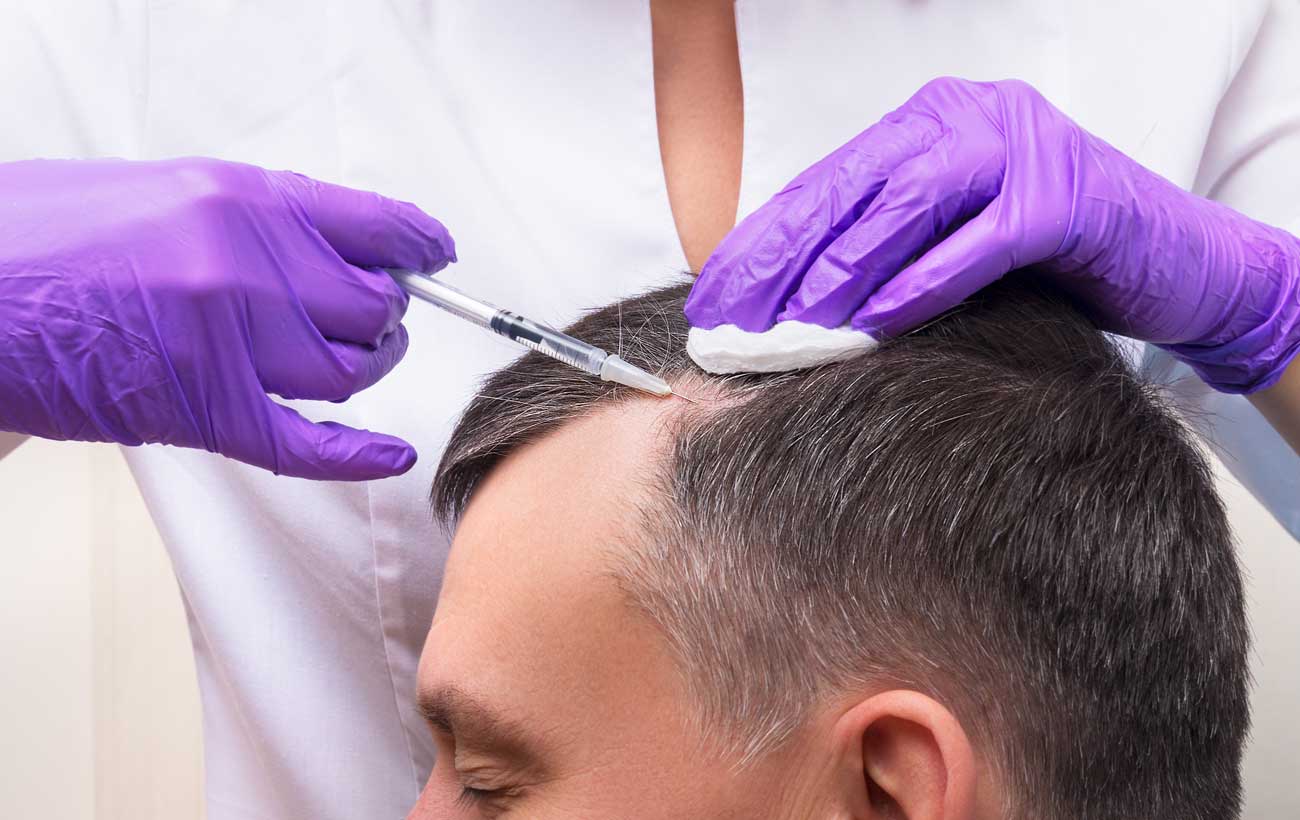Laser Hair Therapy is a low-level laser light treatment that in some studies seems to…

Surgical treatment includes (i) hair transplantation, a procedure where hair follicles are taken from the back and sides of the scalp and transplanted onto the bald areas; and (ii) Scalp expansion, flap transposition, and scalp reduction, where a section of the bald area is removed and the hair-bearing scalp stretched to cover the gap. Tissue expanders may be used to stretch the skin. www.plasticsurgery-sydney.com.au
scalp reduction (permanent solution)
Scalp reduction is usually performed using local anesthetic in the scalp, along with a sedative to assist you to relax and reduce anxiety. Usually, a portion of the scalp, two to five centimeters wide, can be removed in one session, and the remaining skin is then stitched back together. Newer techniques of scalp reduction may also be used: these include scalp expansion and scalp extension and are explained below.
scalp expansion (permanent solution)
With a scalp expansion, balloon-like devices named tissue expanders are implanted under the sides and back of the scalp where the hair is still growing. These are gradually inflated over a four-to-twelve-week period, resulting in an increase in the amount of loose hair bearing tissue as the skin stretches. The following scalp reduction surgery produces a greater amount of loose bald skin than would be possible if it had not been stretched before surgery.
Scalp extension (also known as Frechet Extender, permanent solution)
Scalp extension involves the usage of a surgical device, made of two rows of hooks linked by elastic bands. This device is placed on the beneath surface of the scalp during the first scalp reduction procedure. Over a one-month period, the tension in the bands gets tighter which constantly and gently pulls upwards on the hair-bearing tissues. This loosens and stretches the scalp. This allows for another, and normally greater, scalp reduction to be done.
With scalp extension, a faster series of scalp reductions can be completed within a 30- to 90 – day period. In the past, some scalps could not be reduced at all and those that could be reduced often took a year or longer for the procedures to be accomplished. The treatment is much quicker now!
Scalp extension has some of the benefits of scalp expansion, however causes less discomfort and deformity. Though, the amount of tissue stretch is generally less than can be achieved with scalp expansion devices.
After scalp reduction surgery
Patients usually experience swelling and some numbness for the first few days following the procedure. Because the skin needs time to soften, tightness in the scalp is also common for several months after the operation. You will be going home on the same day, the wound on the scalp require no dressing after the procedure.
The scalp will remain numb for 12-24 hours, following that you will need simple analgesia.
A follow up appointment will be arranged in 7-10 days after surgery.
You will need to avoid: sun exposure for a week and any strenuous work that may contribute to increase in your blood pressure.
Getting back to work and normal activities
You should be able to slowly resume normal daily activities over the next several days.
Shampooing and gentle combing can be started next day.
Most patients will be able to return to work within 3-5 days following the procedure.
Strenuous activity must be kept to a minimum for 10 days.
Most patients who decide to undergo scalp reduction are satisfied with the results.
While there may be particular scarring around the incision, it is usually covered by hair. A hair transplant procedure can be used to better cover the scars.
Hair transplantation
www.hairsciencescenter.com
Follicular unit hair transplantation (FUHT)
Follicular Unit Hair Transplantation is a procedure that results in natural hair. There are two FUHT graft harvest methods: Follicular Unit Strip harvest (FUS or simply Strip Method) and Follicular Unit Extraction (FUE), although FUE is increasingly the method of choice, since the results are 100% undetectable, and leave no linear scar.
Efficacy of hair follicle transplant
Our hair naturally grows in groupings of one, two, three and four hairs called follicular units. When the follicular unit grafts are harvested and transplanted by our highly trained team, lost hair can be replaced and hair density can be increased in the most undetectable and natural way possible.
FUHT is an excellent option for:
- Male Pattern Baldness
- Female Pattern Baldness
- Scars from Cosmetic Surgery
- Missing or Thinning Eyebrows
- Correcting Previous Hair Transplants
- High Hairlines
Follicular unit extraction (FUE)
An FUE hair transplant is a minimally invasive, outpatient procedure that is virtually painless and leaves no linear scar. The hair follicles are removed from the donor site (usually the back of the head), then transplanted hair-by-hair to the thinning or bald area. The result is 100% natural, undetectable and permanent.
FUE stands for Follicular Unit Extraction, a state-of-the-art, minimally invasive hair transplant method for obtaining follicular units from the donor area, currently in use around the globe. Because the amount of skin tissue obtained to extract a single follicular unit is very small, the procedure is minimally invasive and virtually undetectable. For a given number of grafts, the amount of skin tissue removed during FUE is approximately 35-45% less than the amount of skin removed with a strip harvest of the same number of grafts.
No-Shave FUE
In no-shave follicular unit extraction only the donor follicle hairs are trimmed, all other hair remains the same length. The trimmed donor follicles are therefore hidden amidst the remaining full-length hair, and a completely normal appearance post-transplant is achieved. Suitable for both men and women, this technique makes both the process and eventual outcome of a hair transplant undetectable.
FUE is an excellent option for:
- Male Pattern Baldness
- Female Pattern Baldness
- Scars from Cosmetic Surgery
- Missing or Thinning Eyebrows
- Correcting Previous Hair Transplants
- High Hairlines
Method may be right for you in a personal consultation.
Follicular unit strip method (FUS)
The strip method is a method of obtaining follicular units from a donor strip taken from an area of non-balding scalp at the back and sides of the head, removing the grafts from the strip using operating microscopes, and then transplanting the grafts in the bald or thinning areas. This is a method of obtaining grafts from the donor area whereby a strip of skin is removed from the donor area under local anesthesia. The donor site incision is sutured closed and follicular unit grafts are dissected free from the strip using stereomicroscopic dissection. This method is in contrast to follicular unit extraction (FUE) where the grafts are removed directly from the donor area one at a time.
FUS is an excellent option for:
Strip method over individual follicle unit extraction
- Less expensive
- Patient’s preference
- Doctor determines that given the individual’s profile, this procedure is a better surgical option
Scar from a strip harvesting
The scalp is very elastic. When the donor strip of hair is removed, the scalp on both sides is simply pulled together and sutured. The only evidence of surgery is a thin, horizontal line hidden under the hair on the back or side of the head. The scar usually resembles the crease of the palm of your hand. Immediately after surgery, the scar is hidden in your hair. It should not be visible unless your hair is lifted up. After healing, the scar is virtually impossible to find. The length of the scar will depend on the number of grafts needed. Larger sessions will require a longer scar and vice versa.
Trichophytic Closure
This a special strip closure technique whereby the surgeon will treat one wound edge in a way to induce hair to grow through the scar to make it less visible when the hair is worn short. This technique works well but it is not 100% effective in eliminating all scar visibility.
After you have healed, you can cut your hair fairly short. Do understand, however, that scars will be detectable if your hair is so short that it does not layer or lie down in back. No matter how fine they are, scars do create some distortion in the skin.
Shaving my head after a strip harvest
If you are considering shaving your head, hair transplant surgery – of any kind – is probably not in your best interest. The point of hair transplantation is to not look bald. If you have had a strip harvest, shaving your head will reveal the small skin distortions that naturally accompany graft placement, and the donor area scar will likely be visible.
Facial hair transplant
Facial hair transplantation is a surgical procedure that restores hair to areas of the face where hair is thin or missing. The procedure can focus on one or more of these facial hair areas: the beard, goatee, mustache, sideburns, cheeks and eyebrows. Beard transplants, mustache transplants and sideburn transplants are often pursued to create a more “masculine” look, but may also be used to conceal acne, burn or accident scars.
Just like with in an ordinary hair transplant surgery, the donor hairs are harvested from the back and/or sides of the scalp, or other areas, depending on the best match Dr. Vafaei employs the Follicular Unit Extraction (FUE) method for facial hair transplants. FUE transplants are a minimally invasive, outpatient procedure that is virtually painless and leave no linear scar.
If your scalp hair is thinning, you may want to avoid a facial hair transplant procedure, because those donor hairs, once removed from your scalp, will no longer be available in future should a hair transplant be needed to address thinning scalp hair or male pattern baldness.
Once transplanted, hairs fall out 2 weeks post-surgery, then begin to regrow at around 3 months, after which time the facial hairs will be permanent. They can be shaved or groomed just like the beard, mustache or sideburn hairs that existed prior to the procedure.
Sideburn transplant
A sideburn transplant is a surgical procedure that restores hair to the sides of your face where growth may be thin, spotty, or missing altogether. It can also be performed to conceal acne scars, or other types of scarring.
Grafts needed for a sideburn transplant
The number of grafts needed for each sideburn is approximately 100 – 250, but an individual evaluation is needed to assess your unique situation and determine graft number. Just like with in an ordinary hair transplant surgery, the donor hairs for a sideburn transplant are harvested from the back and/or sides of the scalp. Dr. Vafaei will determine the most appropriate donor site, depending on which areas of the head are the closest match to your existing sideburn hair. He then employs the Follicular Unit Extraction (FUE) method or Follicular Unit-strip harvest technique for facial hair transplants.
The follicular units are harvested and transplanted. The hairs are then permanent and typically grow just like your existing facial hair, with similar texture and other characteristics. The end result is natural hair that will never fall out, and will continue to grow for a lifetime. It will require trimming and shaving, as though it had been there forever. It’s your own hair, right where you want it to be.
Please note that if your scalp hair is thinning, you may want to avoid a facial hair transplant procedure, because those donor hairs, once removed from your scalp, will no longer be available in future should a hair transplant be needed to address thinning scalp hair or male pattern baldness.
Eyebrow transplant
An eyebrow transplant is a minimally invasive, outpatient procedure that transplants hairs one-by-one from a person’s donor area (usually the back of their head) to the eyebrow, to address thinning or scarred eyebrows. It is virtually painless and can be completed in one day. It leaves no scarring in the donor area and is 100% natural, undetectable and permanent once complete. This type of eyebrow restoration creates a truly natural look—unlike tattooing or dying, which can result in a fake or “painted on” look. Part science and part artistry, an expertly performed FUE eyebrow transplant is virtually undetectable because transplanted hairs blend with the existing brow hair follicles, and mimic your natural color because the follicles are your own. A lush brow can frame the face, provide depth and enhance expression.
The art of the eyebrow transplant
Strong, sensual or delicate, healthy eyebrows can amplify emotion, and create a deeper, more nuanced expression. An eyebrow hair transplant is a highly artistic procedure that should only be conducted by an experienced transplant surgeon. A consultation is essential to discuss outcome desires and expectations. The transplant plan will be individually designed based on the following factors:
- Your facial type
- Your features
- Arch shape
- Thickness of existing brow hair
- Thickness, color, texture and curl of harvest hair
- Space between brows
- Brow length
- Your personal desires regarding the end results
Eyebrow transplants look
If your eyebrows are thin or nearly non-existent, the last thing you want is a transplant that looks fake, phony or just plain odd. Dr. Vafaei is extremely skilled in matching the natural look texture, color and orientation of your brows, hair and skin tone. The result will amplify and enhance your eyes and face, naturally. The end result is undetectable as a transplant, even to those closest to you.
Eyelash transplant
An eyelash transplant is a minimally invasive, outpatient procedure that transplants hairs one-by-one from a person’s donor area (usually the back of their head) to the eyelids, to address thinning or non-existent eyelashes. It is virtually painless and can be completed in one day. It leaves no scarring in the donor area and is 100% natural, undetectable and permanent once complete.
Causes of eyelash loss
- the overuse of eyelash extensions can cause permanent eyelash loss
- the overuse of false eyelashes can cause permanent damage, because the glue can clog the natural lash follicle
- burns or other medical conditions
- natural hormonal changes due to aging
British Association of Dermatologists | www.bad.org.uk



